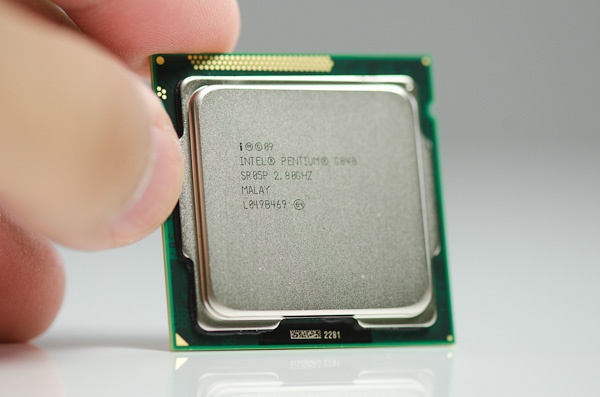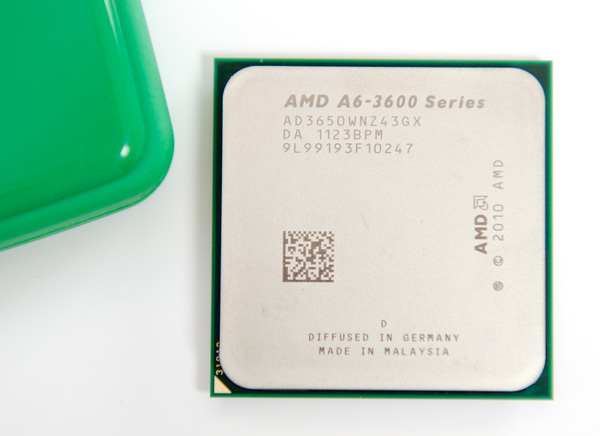The Sandy Bridge Pentium Review: G850, G840, G620 & G620T Tested
by Anand Lal Shimpi on August 23, 2011 12:11 AM ESTFinal Words
Despite boasting Intel's latest Sandy Bridge microarchitecture, the conclusions here are pretty much unchanged from the past. Intel maintains an advantage when it goes up against an AMD chip with the same number of cores, almost regardless of clock speed. In the case of the Pentium G620, even an Athlon II X2 265 with a 27% clock speed advantage can't outperform the Sandy Bridge based CPU. If you're choosing between chips with the same number of cores at the same price, Intel wins.
The decision tilts in AMD's favor if you start comparing to the Athlon II X3. In heavily threaded workloads, the Athlon II X3's third core helps put it ahead of the entire SNB Pentium lineup. If you're building a machine to do offline 3D rendering, multithreaded compiling or video transcoding then AMD continues to deliver the best performance per dollar. It's in the lighter, less threaded workloads that the Pentium pulls ahead. If you're building more of a general use system (email, web browsing, typical office applications and even discrete GPU gaming), the Pentium will likely deliver better performance thanks to its ILP advantages. What AMD has offered these past couple of years is an affordable way to get great multithreaded performance for those applications that need it.
Unfortunately the entire Sandy Bridge Pentium lineup is clock locked. Without turbo modes there's no support for overclocking at all. While these new Pentiums would have normally been great for enthusiasts looking to overclock, Intel has ensured that anyone looking to get more performance for free at the low end will have to shop AMD. Unfortunately Intel's advantage in single/lightly threaded performance is big enough that a clock speed advantage alone is generally not enough to make up for it (see G620 vs. Athlon II X2 265 comparison). It's sad that it has come to this. I was hoping we'd see more K-series SKUs at the low end but it seems like those will only be for the enthusiasts at the high end.
The Pentium's on-die GPU isn't particularly impressive. It's the HD Graphics 2000 from the rest of the Sandy Bridge lineup without Quick Sync or any of the extra video features. I am particularly sad that Quick Sync is missing as it would've made these Pentiums extremely attractive for users that do a lot of video transcoding. Thankfully video decode acceleration and HD audio bitstreaming support remain, so if you're looking to build a cheap Sandy Bridge based HTPC and don't care about the frills these chips will work just fine.
However, if you're building a system to do any sort of 3D gaming you're much better off either springing for a cheap discrete card or looking at AMD's A6-3650 if you want to stay integrated. Although you can play older titles at low resolution on the Pentium's on-board GPU, you'll have a much better experience with a discrete GPU or with the A6.
It all boils down to this. If you want a good, cheap, general purpose PC then the Pentium G620 seems competent and cheap. You can consider the G840 if you want a bit more performance. If you do a lot of threaded work (e.g. offline 3D rendering) the next step up is the Athlon II X3 455. If you do any amount of consumer level video transcoding using apps that are Quick Sync enabled, opt for the Core i3 2100 instead. If gaming is important to you then either buy a discrete GPU or look to AMD's Llano.
As far as AMD's A6 vs. A8 goes, the A8-3850 only commands a $20 price premium over the A6-3650. That $20 gives you another 8 - 10% on the CPU side and around 20% on the GPU. In my opinion, if you're considering a Llano system - spring for the A8.












110 Comments
View All Comments
blazeoptimus - Tuesday, August 23, 2011 - link
I realize that this mostly focuses on desktop parts, but in the mobile space, the e-350 tends to go head to head with a B940, (which is a slower version of the G620T). Something most stores (ala BestBuy) will say is that if you want graphics performance, go with the e-350 based laptop, and if you want cpu power, go with the B940 laptop. I suspect, that other than HTPC specific tasks, the B940 is a generally superior option.flipmode - Tuesday, August 23, 2011 - link
article quote:None of the Pentiums support AES-NI or VT-d.
Wait, wait, wait - so does that mean that you can't run Windows XP Mode or just that it will have fairly crummy performance?
Either way, that's a deal breaker for me.
elevants - Tuesday, August 23, 2011 - link
They don't support Intel® Virtualization Technology for Directed I/O (VT-d)They all do support VT-x. And XP mode runs fine.
Besides XP mode runs without VT-x as well.
For VT-d you need platform support anyway.
So no deal breaking here. :)
More info: http://ark.intel.com/products/53490/Intel-Pentium-...
kallogan - Tuesday, August 23, 2011 - link
The power consumption graphic is weird, we can see that the core i3 2100 is consuming more juice tha the core i3 540 when loaded. But i have an itx core i3 2100 setup and it consumes only 59W when loaded ( 4GB ram/corsair F60 + 2,5" 320GB seagate 7200tr). My previous itx setup with a core i3 530 was consuming 77W when loaded. So i'm not sure about your results.Belard - Tuesday, August 23, 2011 - link
I think it would have been nice to have the AMD Phenom II X4 840 (3.2GHz) thrown into this crowd. Its still in production. It sells for $100 on Newegg.And Texas Microcenter, they've been selling it for $50 (with purchase of a motherboard $80+). For $50, its a steal compared to these chips.
Wish the A8 & A6 CPUs were cheaper... the A6-3650 should be a $99 CPU, tops.
kallogan - Tuesday, August 23, 2011 - link
the AMD Phenom II X4 840 is nothing more than an athlon II X4, it doesn't have any L3 cache. It's a name scam.CeriseCogburn - Monday, June 25, 2012 - link
Amd's massive rebranding, far worse than the one that always gets blamed for rebranding.When will amd fans face the truth ?
Malih - Tuesday, August 23, 2011 - link
I'm thinking of possible inclusion of system value comparison on this type of CPU tests, you can't possibly think about buying just the CPU nowadays right, you can't do anything with just CPU.I mean which one of the systems built using any of these CPUs would offer more features (eSATA, USB 3.0, Gigabit Ethernet, 7.1 Audio, VT-D, SSE, Solid Capacitor, DXVA and so on) at the same price point.
Arnulf - Tuesday, August 23, 2011 - link
This obviously depends on the motherboard you decide upon and with the range of chocies avaliable you can get just about anything you can think of for either platform (FM1 or LGA1155).racingpht - Tuesday, August 23, 2011 - link
There must be some problem with Crysis:Warhead benchmark. Why is1680x1050 faster than 1024x768?